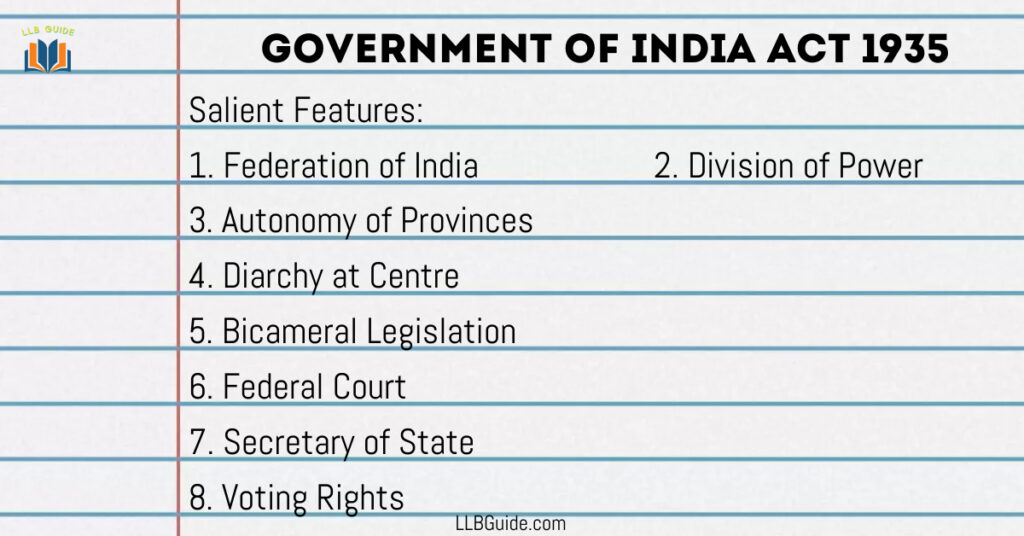Government of India Act 1935 played an important role in the constitutional development of Pakistan. When Pakistan became an independent state, it was adopted as the country’s interim constitution with some amendments.

Table of Contents
What is the Government of India Act 1935?
After the Round Table Conference failed, a white paper was issued on its suggestions and efforts were started to make the constitution of India. Under the chairmanship of Lord Linlithgow (the viceroy of India) a Joint Select Committee was set up. The Joint Select Committee published its report in 1934. By this report, the Government of India Act 1935 was passed on 24 July 1935 by the British Parliament and came into force on 1 April 1937. It consisted of two parts, central and provincial.
Salient Features of the Government of India Act 1935
Following were the salient features of the Government of India Act 1935 aka Constitution of India 1935:
1. Federation of India
Under this Act, an all-India federation was established which consisted of all the colonies of Britain under British India and all the Princely States. The Princely states were free to join the Federation of India. It was their choice whether to join it or not.
2. Division of Power
The Government of India Act laid a lot of powers to the Centre. However, it introduced the division of power regarding legislation between the centre and the provinces. The centre and the provinces could not interfere with other’s subject lists.
The following three lists were established:
1. Federal List
The Federal Government was authorized to make laws on the subjects mentioned in this list.
2. Provincial List
The Provincial Government was authorized to make laws on the subjects mentioned in the Provincial list.
3. Concurrent List
The Federal and Provincial Governments combined were authorized to make laws on such subjects which were mentioned in the Concurrent list.
3. Autonomy of Provinces
The Government of India Act abolished the concept of diarchy from the provinces and provided self-government and sovereignty to all 11 provinces of the Federation of India. Every province had its head called the Governor with a Council of Ministers to advise him, who had to work under the representative of the Crown in British India (Governor-General).
4. Diarchy at Centre
The Government India Act 1935 introduced the diarchy in the central government. Diarchy is a form of Government having two joint rulers. The Federal subjects were divided into two categories:
1. Reserved
Reserved subjects were completely in the control of the Britishers (Governor-General and his three Executive Councillors).
Reserved subjects included Defence, tribal areas, foreign affairs, Federal Railway, Financial affairs and Reserve Bank.
2. Transferred
Transferred subjects were under the Governor-General and his Council of Ministers (not more than 10). Governor-General’s Council of Ministers included the representatives of British India.
Transferred subjects included Education, Health, Industries and Commerce etc.
5. Bicameral Legislation
The Government India Act introduced the bicameral legislation at the Centre and the following two houses were established for legislation:
- Council of States: It had 260 members.
- Federal Assembly: It had 375 members.
6. Federal Court
The Government of India Act also established the Federal Court in the Federation of India. It had to solve disputes between the Provinces and the Centre. The Federal Court had one Chief Justice and not more than 6 Judges which had been appointed by the Crown.
7. Secretary of State
The Secretary of State was a bureaucrat person to govern the Government of British India. He also had a team of advisors to advise him.
8. Voting Rights
Government of India Act 1935 also provided only 10% voting rights to the people of British India and direct elections were first time introduced in British India by this Act.
9. Sindh and Bombay
This Act also separated the joint province and made two provinces Sindh and Bombay.
10. Bihar and Orissa
The states of Bihar and Orissa were also separated into two provinces.
11. Burma
The Government of India Act 1935 cut off Burma from British India and made it a new colony of British.
Drawbacks of the Government of India Act 1935
The following were the drawbacks of the Government of India Act 1935 aka Constitution of British India 1935:
- The degree of Provincial Autonomy was restricted.
- Everything was under the control of the Britishers.
- This Act neglected the dominion states.
- Indians were not given control of the Government.
- They were not able to amend laws without the assent of the Britishers.
- Defence was also under reserved subject.
- Governors had discretionary powers and were acting like virtual dictators.
- Federal Court was also under the influence of the British.
Conclusion
The Government of India Act 1935 was the first constitution of British India enacted by the UK Parliament. It was provided to give rights and representation to the people of British India because there was a growing demand for independence by the Indians.
FAQs
What is the Government of India Act 1935?
Government of India Act 1935 was the first constitution of British India enacted by the UK Parliament. It was also adopted as an interim constitution by India and Pakistan after independence.
Government of India Act of 1935 provided for the establishment of which institutes
Reserve Bank of India.
What happened in 1935 in India?
The first constitution of British India known as the Government of India Act of 1935 passed.
Which act introduced the system of Dyarchy in India?
Government of India Act of 1935.
Why was the Government of India Act 1935 rejected?
Because everything was under the control of the Britishers.